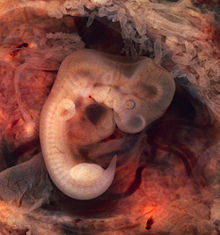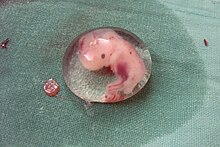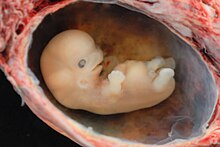
| Home | Sources Directory | News Releases | Calendar | Articles | | Contact | |
Embryo
|
|
This documentation needs attention from an expert on the subject. See the talk page for details. WikiProject Biology or the Biology Portal may be able to help recruit an expert. (November 2008) |

An embryo (irregularly from Greek: á��î�î�ρυî¿î�, plural á��î�î�ρυî�, lit. "that which grows," from en- "in" + bryein "to swell, be full"; the proper Latinate form would be embryum) is a multicellular diploid eukaryote in its earliest stage of development, from the time of first cell division until birth, hatching, or germination. In humans, it is called an embryo until about eight weeks after fertilization (i.e. ten weeks LMP), and from then it is instead called a fetus.
The development of the embryo is called embryogenesis. In organisms that reproduce sexually, once a sperm fertilizes an egg cell, the result is a cell called the zygote that has half of the DNA of each of two parents. In plants, animals, and some protists, the zygote will begin to divide by mitosis to produce a multicellular organism. The result of this process is an embryo.
Contents |
[edit] Animal embryos
In animals, the development of the zygote into an embryo proceeds through specific recognizable stages of blastula, gastrula, and organogenesis. The blastula stage typically features a fluid-filled cavity, the blastocoel, surrounded by a sphere or sheet of cells, also called blastomeres. The embryo of a placental mammal is defined as the organism between the first division of the zygote (a fertilized ovum) until it becomes a fetus. In humans, the embryo is defined as the product of conception from implantation in the uterus through the eighth week of development. An embryo is called a fetus at a more advanced stage of development and up until birth or hatching, although by convention some animals are called embryos all the way through hatching, e.g. chick embryos. In humans, this is from the eighth week of gestation.
During gastrulation the cells of the blastula undergo coordinated processes of cell division, invasion, and/or migration to form two (diploblastic) or three (triploblastic) tissue layers. In triploblastic organisms, the three germ layers are called endoderm, ectoderm and mesoderm. However, the position and arrangement of the germ layers are highly species-specific, depending on the type of embryo produced. In vertebrates, a special population of embryonic cells called the neural crest has been proposed as a "fourth germ layer", and is thought to have been an important novelty in the evolution of head structures.
During organogenesis, molecular and cellular interactions between germ layers, combined with the cells' developmental potential or competence to respond, prompt the further differentiation of organ-specific cell types.[citation needed] For example, in neurogenesis, a subpopulation of ectoderm cells is set aside to become the brain, spinal cord and peripheral nerves. Modern developmental biology is extensively probing the molecular basis for every type of organogenesis, including angiogenesis (formation of new blood vessels from pre-existing ones), chondrogenesis (cartilage), myogenesis (muscle), osteogenesis (bone), and many others.
Generally, if a structure pre-dates another structure in evolutionary terms, then it often appears earlier than the other in an embryo; this general observation is sometimes summarized by the phrase "ontogeny recapitulates phylogeny".[1] For example, the backbone is a common structure among all vertebrates such as fish, reptiles and mammals, and the backbone also appears as one of the earliest structures laid out in all vertebrate embryos. The cerebrum in humans, which is the most sophisticated part of the brain, develops last. This rule is not absolute, but it is recognized as being partly applicable to development of the human embryo.
[edit] The human embryo

- Week 1'3
- 5'7 days after fertilization, the blastula attaches to the wall of the uterus (endometrium). When it comes into contact with the endometrium it performs implantation. Implantation connections between the mother and the embryo will begin to form, including the umbilical cord. The embryo's growth centers around an axis, which will become the spine and spinal cord. The brain, spinal cord, heart, and gastrointestinal tract begin to form.[2]
- Week 4'5
- Chemicals produced by the embryo stop the woman's menstrual cycle. Neurogenesis is underway, showing brain activity at about the 6th week.[3] "The heart will begin to beat around the same time. Limb buds appear where the arms and legs will grow later. Organogenesis begins. The head represents about one half of the embryo's axial length, and more than half of the embryo's mass. The brain develops into five areas. Tissue formation occurs that develops into the vertebra and some other bones. The heart starts to beat and blood starts to flow.[2]
- Week 6'8
- Myogenesis and neurogenesis have progressed to where the embryo is capable of motion, and the eyes begin to form. Organogenesis and growth continue. Hair has started to form along with all essential organs. Facial features are beginning to develop. At the end of the 8th week, the embryonic stage is over, and the fetal stage begins.[2]
[edit] Miscarriage
Some embryos do not survive until the fetal stage, which begins about two months after fertilization (10 weeks LMP). Embryos may be miscarried, or aborted purposely.
Studies using very sensitive early pregnancy tests have found that 25% of embryos are miscarried by the sixth week LMP (since the woman's Last Menstrual Period), even if a woman does not realize it.[4][5] Miscarriages after the sixth week LMP happen in 8% of pregnancies.[5] The risk of miscarriage is "virtually complete by the end of the embryonic period," with a miscarriage rate of only two percent after 8.5 weeks LMP.[6]
The most common cause of miscarriage of an embryo is chromosomal abnormality,[7] which accounts for at least 50% of sampled early pregnancy losses.[8] Advancing maternal age and a patient history of previous miscarriage are the two leading risk factors.[8]
[edit] Induced abortion
The majority of abortions occur during the embryonic period. For example, in England and Wales during 2006, 68% of induced abortions occurred by the end of the embryonic period.[9]
Induced (i.e. purposeful) abortion of an embryo can be accomplished by a variety of methods, including both surgical and non-surgical techniques. Suction-aspiration is the most common surgical method of aborting an embryo.[10]
Common reasons for purposely aborting an embryo include a desire to delay or end childbearing, concern over the interruption of work or education, issues of financial or relationship stability, perceived immaturity and health concerns.[11][12] Abortions may also be performed in an instance where rape or incest results in pregnancy.
[edit] Use in ART and diagnosis
Embryos are used in various techniques of assisted reproductive technology, such as in vitro fertilization and embryo donation. They may be subject to embryo cryopreservation for later use if IVF procedures have resulted in more embryos than is currently needed. Some aspects, e.g. selective reduction, are issues in the beginning of pregnancy controversy.
Prenatal diagnosis or preimplantation diagnosis involves testing embryos for diseases or conditions.
[edit] Viability
A human embryo is not considered viable, because it cannot survive outside the uterus. Current medical technology does allow an embryo to be transplanted from the uterus of one woman to that of another.[13]
[edit] Research
Human embryos are being researched to determine their use in treating diseases. Stem cell research, reproductive cloning, and germline engineering are all currently being explored. The morality of this research is also debated because an embryo is commonly sacrificed.[14][15][16]
[edit] Plant embryos

- Plants: In botany, a seed plant embryo is part of a seed, consisting of precursor tissues for the leaves, stem (see hypocotyl), and root (see radicle), as well as one or more cotyledons. Once the embryo begins to germinate ' grow out from the seed ' it is called a seedling. Plants that do not produce seeds, but do produce an embryo, include the bryophytes and ferns. In these plants, the embryo is a young plant that grows attached to a parental gametophyte.
[edit] Fossilised embryos
Fossilised embryos are known from the Precambrian, and are found in great number during the Cambrian period.
| This section requires expansion. |
[edit] Footnotes
- ^ Gould, Stephen. Ontogeny and Philogeny, p. 206 (1977): "recapitulation was not 'disproved'; it could not be, for too many well-established cases fit its expectations."
- ^ a b c NIH Medical Encyclopedia http://www.nlm.nih.gov/medlineplus/ency/article/002398.htm
- ^ Gazzaniga, Mike S.The Ethical Brain "not until the end of week 5 and into week 6 (usually around forty to forty-three days) does the first electrical brain activity begin to occur."
- ^ Wilcox AJ, Baird DD, Weinberg CR (1999). "Time of implantation of the conceptus and loss of pregnancy.". New England Journal of Medicine 340 (23): 1796'1799. doi:10.1056/NEJM199906103402304. PMID 10362823.
- ^ a b Wang X, Chen C, Wang L, Chen D, Guang W, French J (2003). "Conception, early pregnancy loss, and time to clinical pregnancy: a population-based prospective study.". Fertil Steril 79 (3): 577'84. doi:10.1016/S0015-0282(02)04694-0. PMID 12620443.
- ^ Rodeck, Charles; Whittle, Martin. Fetal Medicine: Basic Science and Clinical Practice (Elsevier Health Sciences 1999), p. 835.
- ^ Stöppler, Melissa Conrad; William C. Shiel, Jr., ed.. "Miscarriage (Spontaneous Abortion)". MedicineNet.com. http://www.medicinenet.com/miscarriage/page1.htm. Retrieved 2009-04-07.
- ^ a b Jauniaux, E.; P. Kaminopetros and H. El-Rafaey (1999). "Early pregnancy loss". in Martin J. Whittle and C. H. Rodeck. Fetal medicine: basic science and clinical practice. Edinburgh: Churchill Livingstone. p. 837. ISBN 0-443-05357-X. OCLC 42792567.
- ^ Department of Health (2007). "Abortion statistics, England and Wales: 2006". http://www.dh.gov.uk/en/Publicationsandstatistics/Publications/PublicationsStatistics/DH_075697. Retrieved 2007-10-12. "68% were at under 10 weeks"
- ^ Healthwise (2004). "Manual and vacuum aspiration for abortion". WebMD. http://www.webmd.com/hw/womens_conditions/tw1078.asp#tw1112. Retrieved 2008-12-05.
- ^ Bankole, Akinrinola, Singh, Susheela, & Haas, Taylor. (1998). Reasons Why Women Have Induced Abortions: Evidence from 27 Countries. International Family Planning Perspectives, 24 (3), 117'127 & 152. Retrieved 2006-01-18.
- ^ Finer, Lawrence B., Frohwirth, Lori F., Dauphinee, Lindsay A., Singh, Shusheela, & Moore, Ann M. (2005). Reasons U.S. women have abortions: quantative and qualitative perspectives. Perspectives on Sexual and Reproductive Health, 37 (3), 110'8. Retrieved 2006-01-18.
- ^ Rumbold, Graham. Ethics in nursing practice, p. 120 (Elsevier Health Sciences 1999).
- ^ Freedman, Jeri. "America Debates Stem Cell Research." New York, NY: The Rosen Publishing Group, 2008.
- ^ Sandel, Michael J. "The Case Against Perfection." Michael J. Sandel, 2007.
- ^ Zavos, Panayiotis. 'Reproductive Cloning is Moral.' Ed. James Woodward. The Ethics of Human Cloning: At Issue. Farmington Hills, MI: Greenhaven, 2005. 14'24.
[edit] See also
- Embryo donation
- Embryo space colonization
- Embryogenesis
- Embryology
- Embryomics
- The Human Embryo: Aristotle and the Arabic and European Traditions (book)
- In vitro fertilization
- Plant embryogenesis
- Pregnancy
- Proembryo
| Preceded by Zygote |
Stages of human development Embryo |
Succeeded by Fetus |
[edit] External links
| Wikimedia Commons has media related to: Embryology |
- Chart of human fetal development
- A Comparative Embryology Gallery
- Development of the human embryo
- The Visible Embryo from fertilization to birth
- The Human Fertilisation and Embryology Authority (HFEA)
- 4-H Embryology, University of Nebraska-Lincoln Extension in Lancaster County
- Dignitas Personae, a summary of the embryonic ethical controversies, from a Roman Catholic perspective (reference: [1])
|
||||||||||||||||||||||||||||||||||||||
|
SOURCES.COM is an online portal and directory for journalists, news media, researchers and anyone seeking experts, spokespersons, and reliable information resources. Use SOURCES.COM to find experts, media contacts, news releases, background information, scientists, officials, speakers, newsmakers, spokespeople, talk show guests, story ideas, research studies, databases, universities, associations and NGOs, businesses, government spokespeople. Indexing and search applications by Ulli Diemer and Chris DeFreitas.
For information about being included in SOURCES as a expert or spokesperson see the FAQ . For partnerships, content and applications, and domain name opportunities contact us.

